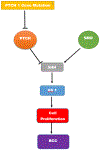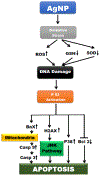Therapeutic strategies and potential implications of silver nanoparticles in the management of skin cancer
- PMID: 33912377
- PMCID: PMC8078871
- DOI: 10.1515/ntrev-2020-0117
Therapeutic strategies and potential implications of silver nanoparticles in the management of skin cancer
Abstract
Skin cancer (SC) is the most common carcinoma affecting 3 million people annually in the United States and millions of people worldwide. It is classified as melanoma SC (MSC) and non-melanoma SC (NMSC). NMSC represents approximately 80% of SC and includes squamous cell carcinoma and basal cell carcinoma. MSC, however, has a higher mortality rate than SC because of its ability to metastasize. SC is a major health problem in the United States with significant morbidity and mortality in the Caucasian population. Treatment options for SC include cryotherapy, excisional surgery, Mohs surgery, curettage and electrodessication, radiation therapy, photodynamic therapy, immunotherapy, and chemotherapy. Treatment is chosen based on the type of SC and the potential for side effects. Novel targeted therapies are being used with increased frequency for large tumors and for metastatic disease. A scoping literature search on PubMed, Google Scholar, and Cancer Registry websites revealed that traditional chemotherapeutic drugs have little effect against SC after the cancer has metastasized. Following an overview of SC biology, epidemiology, and treatment options, this review focuses on the mechanisms of advanced technologies that use silver nanoparticles in SC treatment regimens.
Keywords: basal cell carcinoma; biology; clinical manifestations; epidemiology; malignant melanoma; silver nanoparticles; skin cancer; squamous cell carcinoma; treatment.
Conflict of interest statement
Conflict of interests: The authors declare no conflict of interest regarding the publication of this paper.
Figures




References
-
- Jou PC, Tomecki KJ. Sunscreens in the United States: current status and future outlook. Adv Exp Med Biol. 2014;26:464–84. - PubMed
Grants and funding
LinkOut - more resources
Full Text Sources
